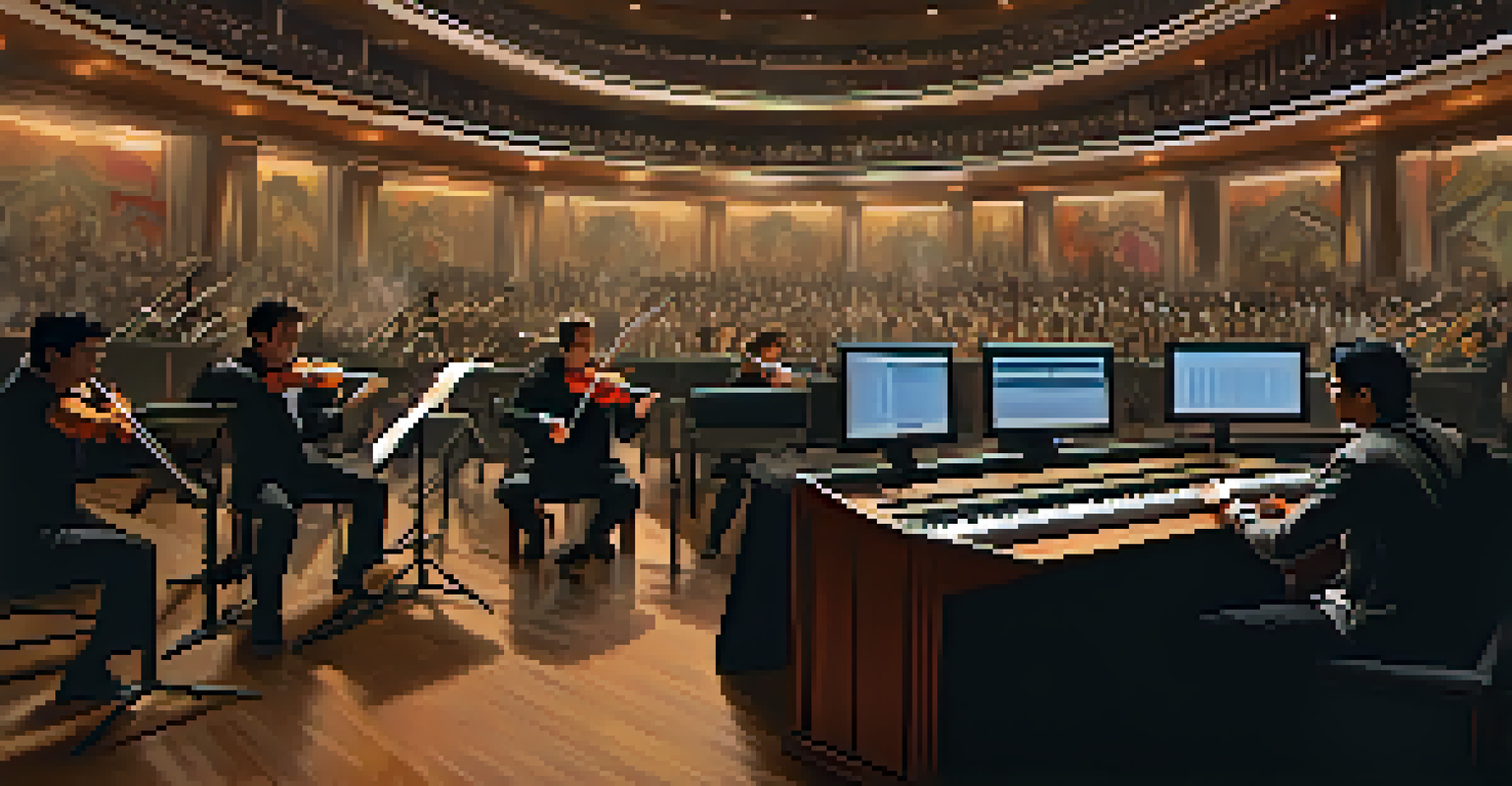Scoring for Different Genres: Tailoring Music to Fit Films

Understanding the Role of Music in Film
Music in film serves as an emotional guide, enhancing the storytelling experience. It can evoke feelings, set the mood, and even foreshadow events, making it a crucial element of cinema. Think of it as the heartbeat of a film, subtly influencing how we perceive each scene.
Music can change the world because it can change people.
Different genres require unique musical elements to resonate with their audiences. For instance, a romantic film might lean on soft strings to evoke tenderness, while a horror movie could employ dissonant chords to build suspense. This tailored approach ensures that the music aligns perfectly with the narrative's emotional arc.
Ultimately, scoring is about creating a cohesive experience. When done well, the music becomes so intertwined with the visuals that it feels like an inseparable part of the film, enriching each moment and leaving a lasting impression on viewers.
Scoring for Action Films: High Energy and Drive
Action films thrive on adrenaline, and the score plays a pivotal role in ramping up the intensity. Composers often use driving rhythms and orchestral swells to match the fast-paced action on screen. This connection between the visuals and audio keeps audiences on the edge of their seats.

Take the iconic scores of franchises like 'Mad Max' or 'Die Hard'; they're packed with powerful percussion and electrifying melodies that complement the thrilling visuals. The relentless energy of the score mirrors the urgency of the scenes, creating a synergy that heightens the overall experience.
Music Enhances Film Emotion
Music acts as an emotional guide, enhancing storytelling by evoking feelings and setting the mood for each scene.
Moreover, sound design in action films often incorporates elements like explosions and gunfire, which blend with the score to create a more immersive atmosphere. This combination of music and sound effects ensures that viewers feel every pulse of action, making the score an integral part of the film's narrative.
Crafting Romantic Scores: Evoking Emotion and Intimacy
In romantic films, music becomes a vehicle for expressing love and connection. Composers often use lush strings, gentle piano melodies, and soft vocals to evoke feelings of warmth and intimacy. This creates an emotional backdrop that enhances the relationships depicted on screen.
Without music, life would be a mistake.
Think of classic romance films like 'The Notebook' or 'Pride and Prejudice,' where the scores linger in your memory long after the credits roll. These scores often feature recurring themes that underscore pivotal moments, allowing audiences to feel the weight of love and longing.
Additionally, the use of silence can be just as powerful in romantic scoring. A well-timed pause can heighten tension during a moment of vulnerability, making the eventual musical swell all the more impactful. This delicate balance is key to crafting a score that resonates deeply with viewers.
Creating Tension in Horror: Dissonance and Surprise
Horror films rely on music to build tension and evoke fear, often using dissonance and unexpected shifts to keep viewers unsettled. Composers frequently employ eerie soundscapes, unsettling harmonies, and sudden crescendos to create an atmosphere of dread. This musical approach sets the stage for the visual scares that follow.
For example, the iconic score of 'Psycho' uses sharp, staccato strings to heighten the tension during the infamous shower scene. The jarring sounds mirror the chaos of the moment, creating a visceral reaction in the audience. This technique illustrates how music can amplify the emotional intensity of a scene.
Genre-Specific Scoring Techniques
Different film genres require tailored musical elements, such as driving rhythms for action or lush strings for romance, to resonate with audiences.
Moreover, silence is a powerful tool in horror scoring. A sudden drop in sound can create a moment of suspense, making the audience hold their breath in anticipation. When the music finally swells back in, it hits even harder, providing a spine-chilling jolt that lingers long after the film ends.
Scoring Comedies: Lightness and Playfulness
In comedies, music often serves to amplify humor and create a lighthearted atmosphere. Composers use playful melodies, quirky instrumentation, and upbeat tempos to match the comedic tone of the film. This helps to engage viewers and enhances the overall fun of the experience.
Consider the whimsical scores in films like 'The Grand Budapest Hotel' or 'Bridesmaids,' where the music adds an extra layer of charm. These scores often feature catchy tunes that can make even mundane moments feel amusing, reinforcing the comedic timing and delivery of the actors.
Additionally, sound effects and musical cues are often timed perfectly with visual gags, creating a harmonious blend of audio and visual humor. This synchronization not only elicits laughter but also makes the score an integral part of the comedic storytelling process.
The Importance of Cultural Context in Scoring
When scoring films, understanding cultural context is vital for authenticity and resonance. Different cultures have unique musical traditions and emotional expressions, which composers can draw upon to create more relatable scores. This cultural sensitivity enriches the film and connects it to its intended audience.
For instance, a film set in Japan might incorporate traditional instruments like the shamisen or koto to evoke a sense of place and cultural identity. This not only enhances the authenticity of the film but also deepens the audience's emotional connection to the story being told.
Collaboration Shapes Film Scores
The collaborative relationship between composers and filmmakers is crucial in crafting scores that align with the film's narrative and emotional landscape.
Furthermore, global influences can lead to innovative scoring techniques that blend genres and styles. This fusion can create a fresh, exciting sound that appeals to diverse audiences, demonstrating the power of music as a universal language in cinema.
The Collaborative Process: Composers and Filmmakers
The relationship between composers and filmmakers is a collaborative dance that shapes the final score. Filmmakers often have a vision for their film's emotional landscape, and composers work to bring that vision to life through music. This collaboration ensures that the score aligns seamlessly with the film's narrative.
For example, directors may provide specific references or cues for the music, guiding composers toward the desired tone. This back-and-forth communication helps to refine the score, allowing it to enhance the film's atmosphere and emotional depth effectively.

Moreover, the collaborative process can lead to unexpected creative breakthroughs. Sometimes, a composer might suggest a unique musical direction that surprises the filmmaker, leading to a score that elevates the film in ways they hadn't initially imagined. This synergy between composers and filmmakers is essential for crafting memorable cinematic experiences.
Conclusion: The Art of Tailoring Music for Film
Scoring for different genres is an art form that requires a deep understanding of both music and storytelling. Each genre presents unique challenges and opportunities for composers, who must tailor their scores to evoke the desired emotions and enhance the narrative. This skillful adaptation is what makes film music so powerful.
As we've explored, the right score can transform a film, making it more engaging and memorable for audiences. Whether it's the adrenaline of an action sequence or the tenderness of a romantic moment, music plays a pivotal role in shaping the viewer's experience.
Ultimately, the collaboration between composers, filmmakers, and the cultural context of a film creates a rich tapestry of sound that resonates with audiences. By understanding the nuances of different genres, composers can craft scores that not only complement the visuals but also elevate the entire cinematic journey.